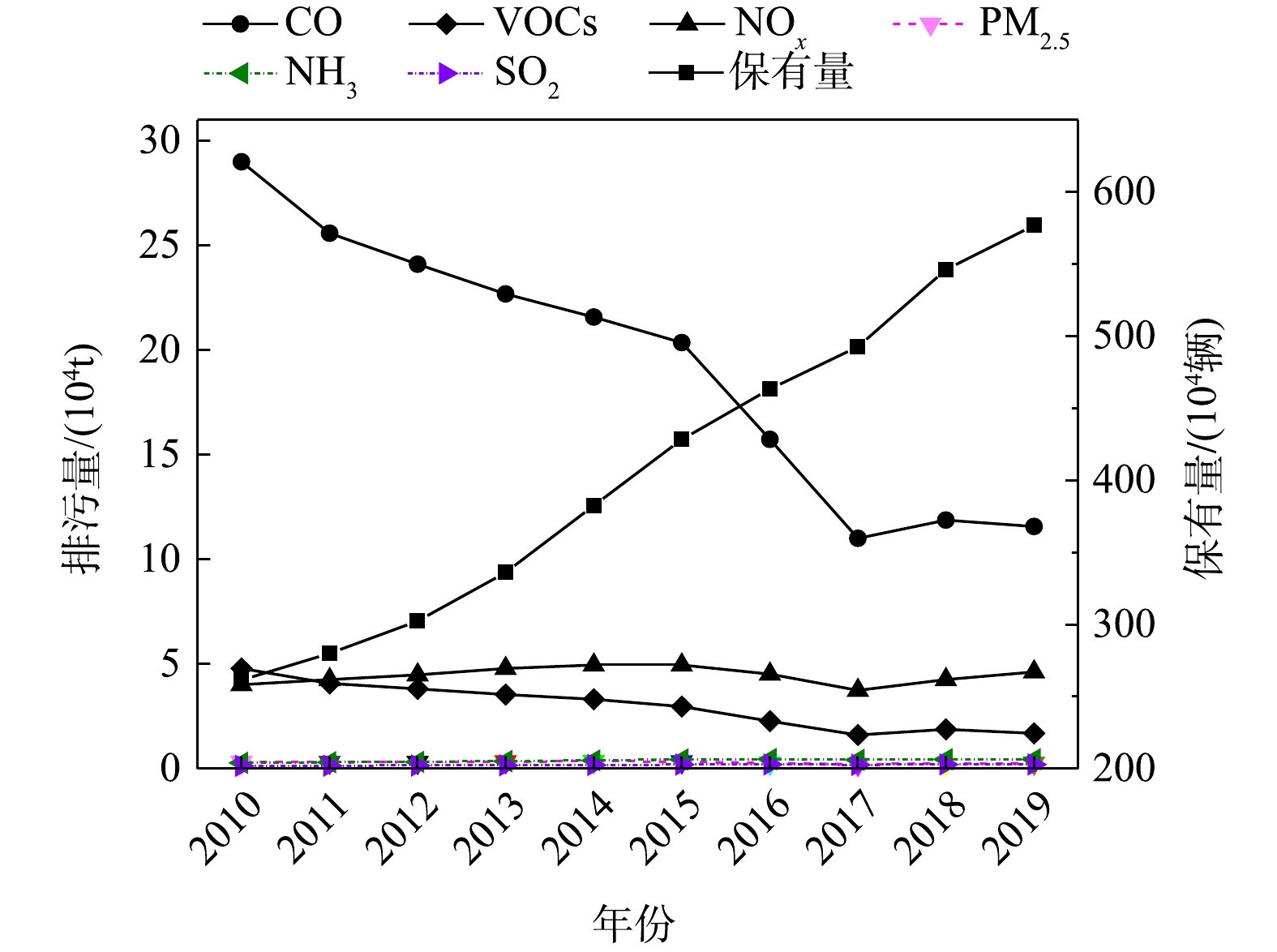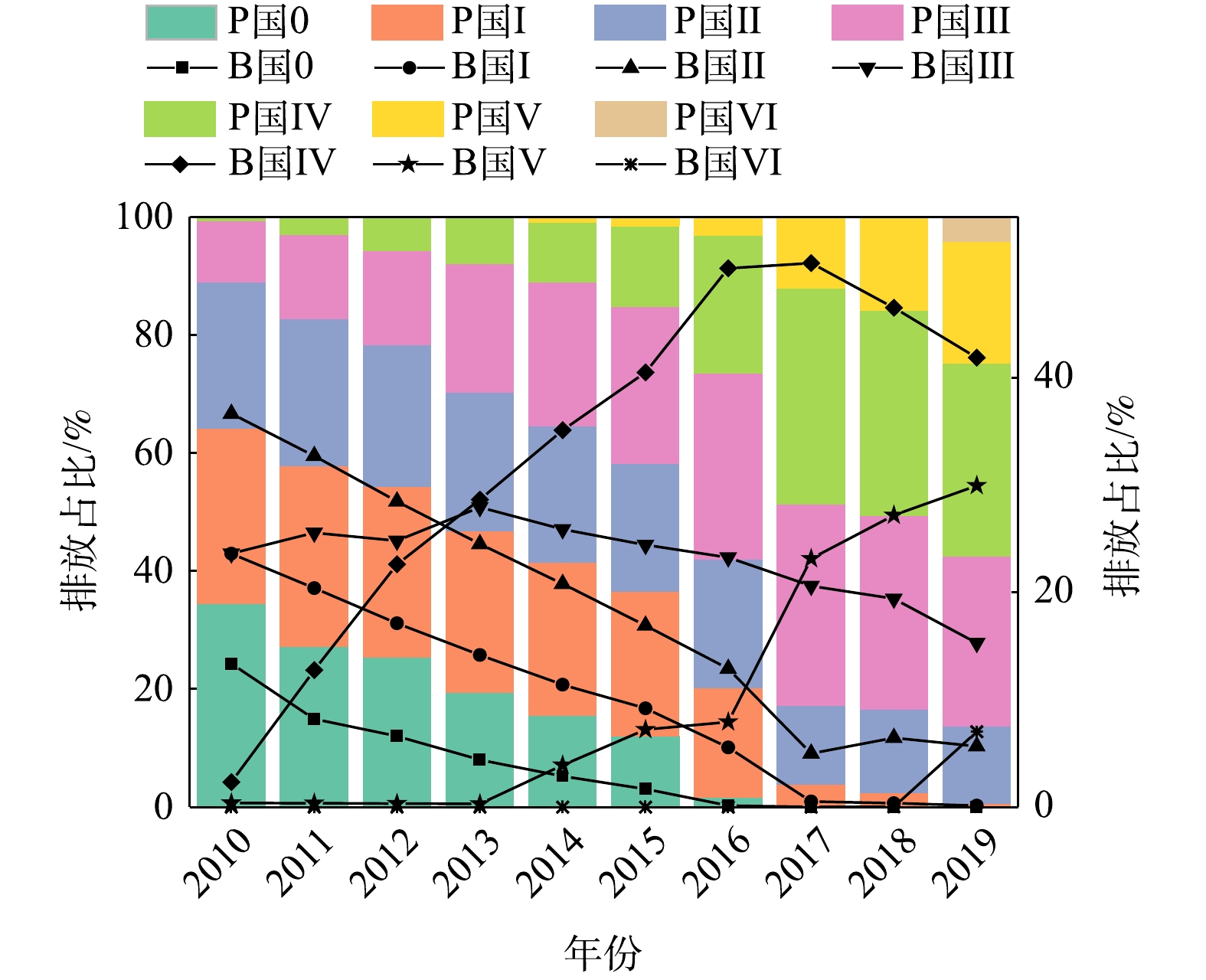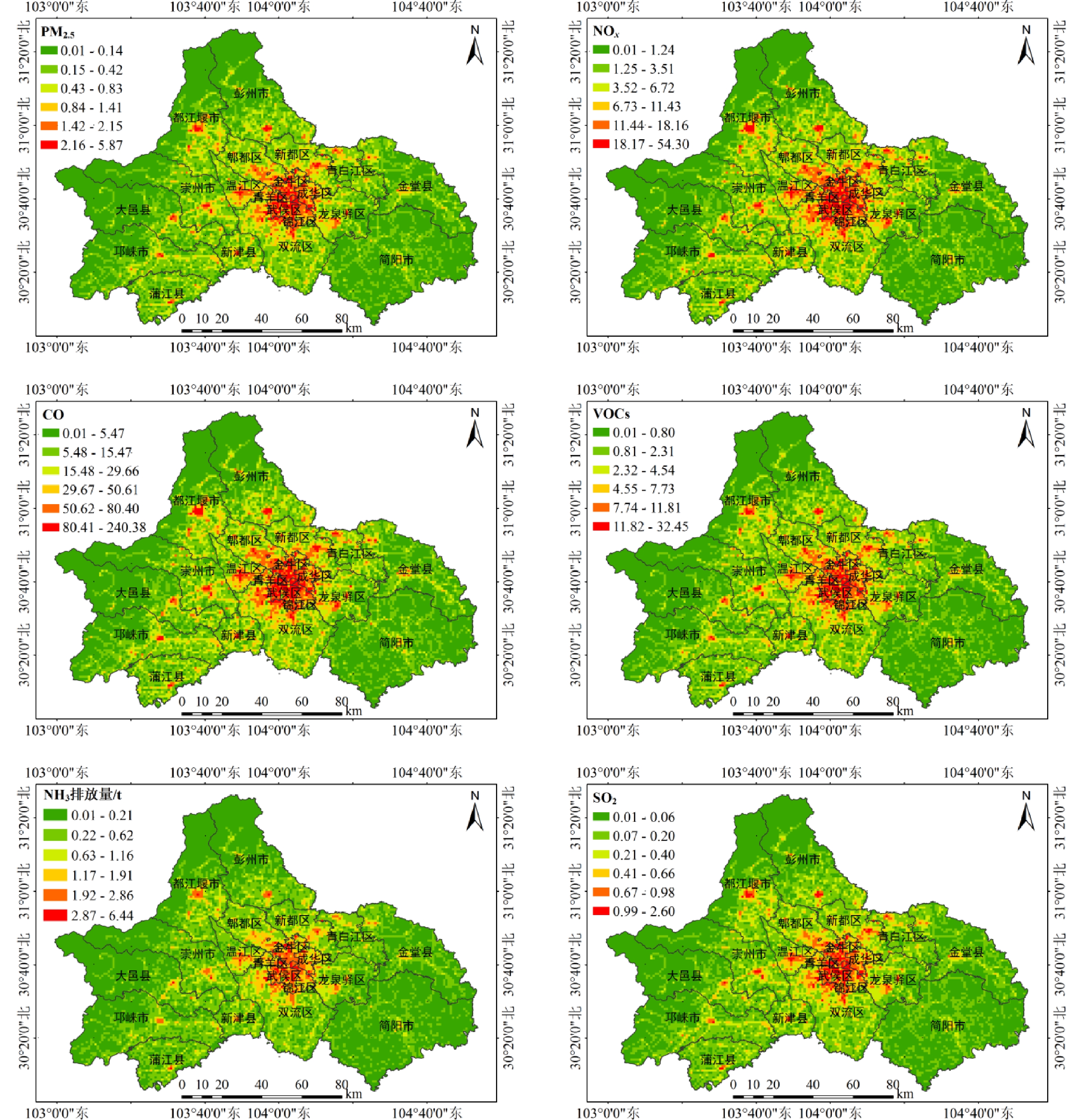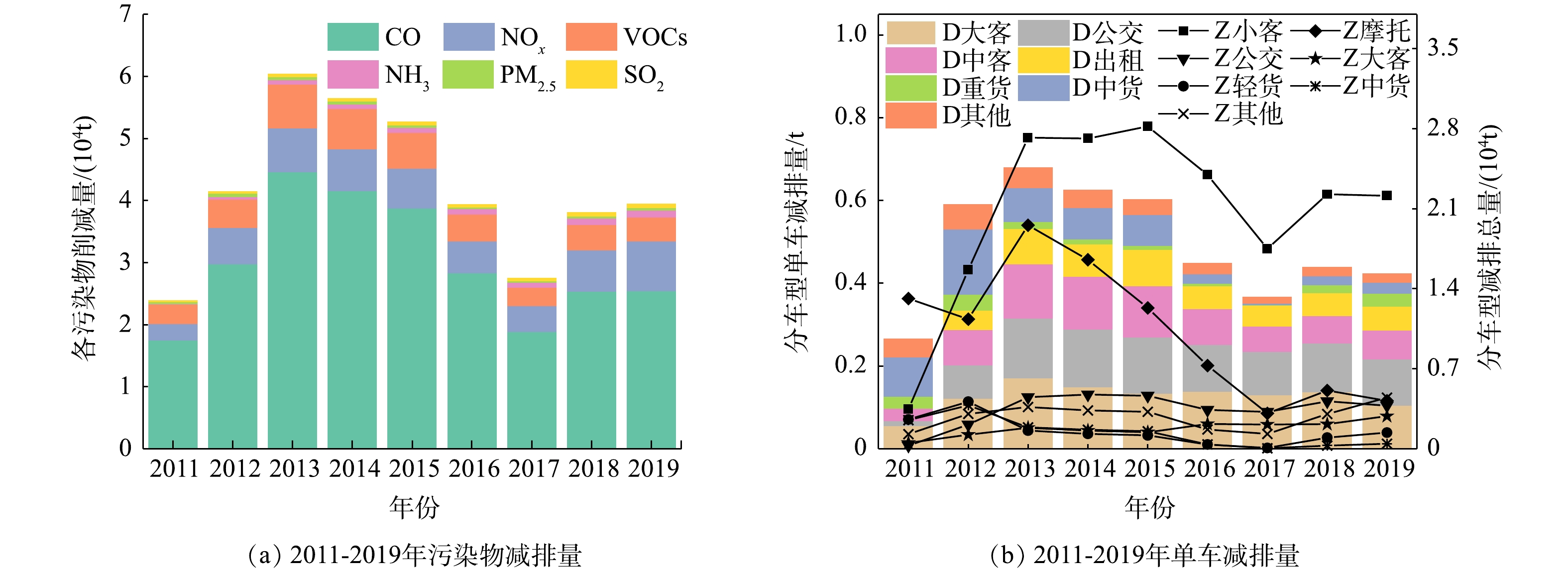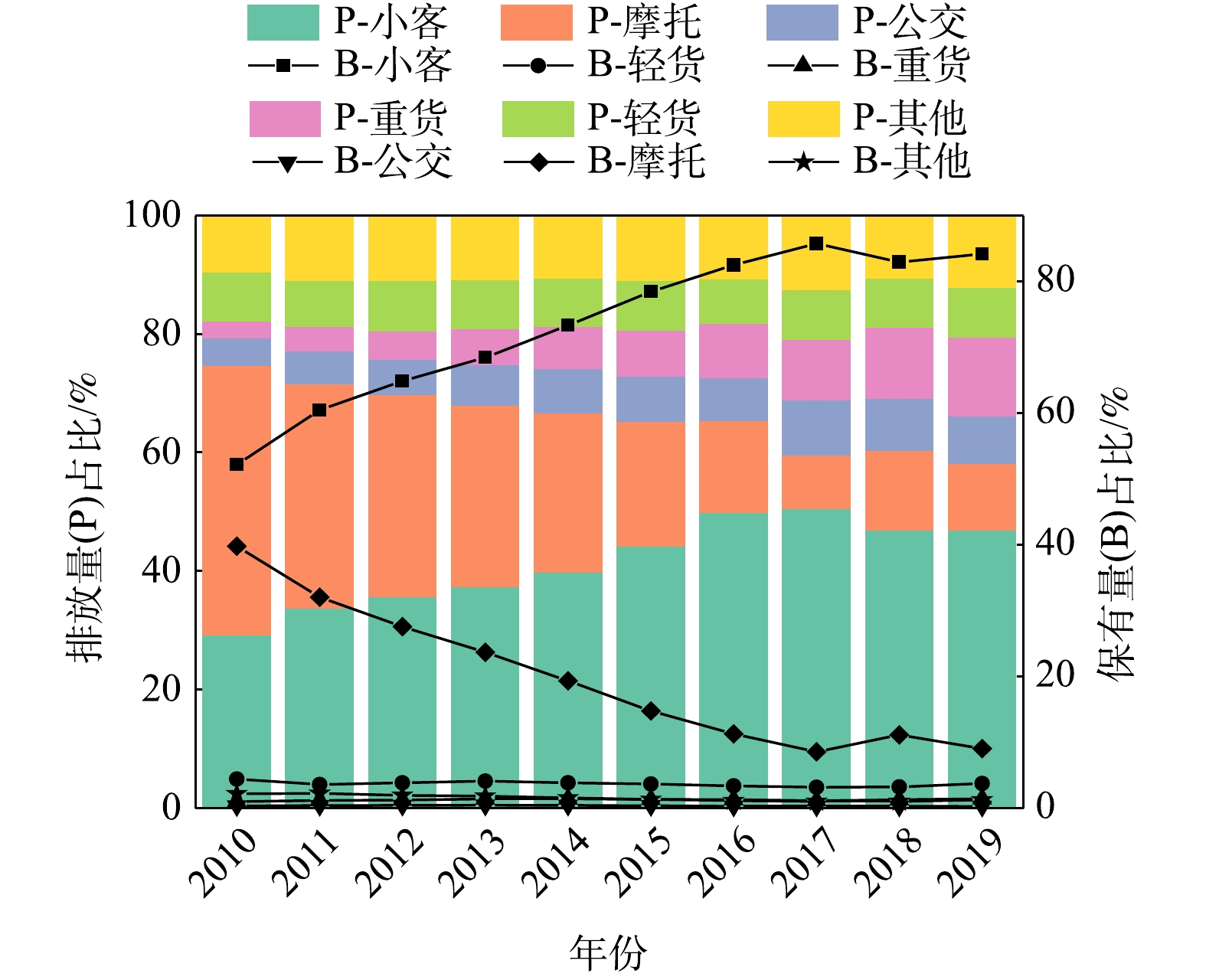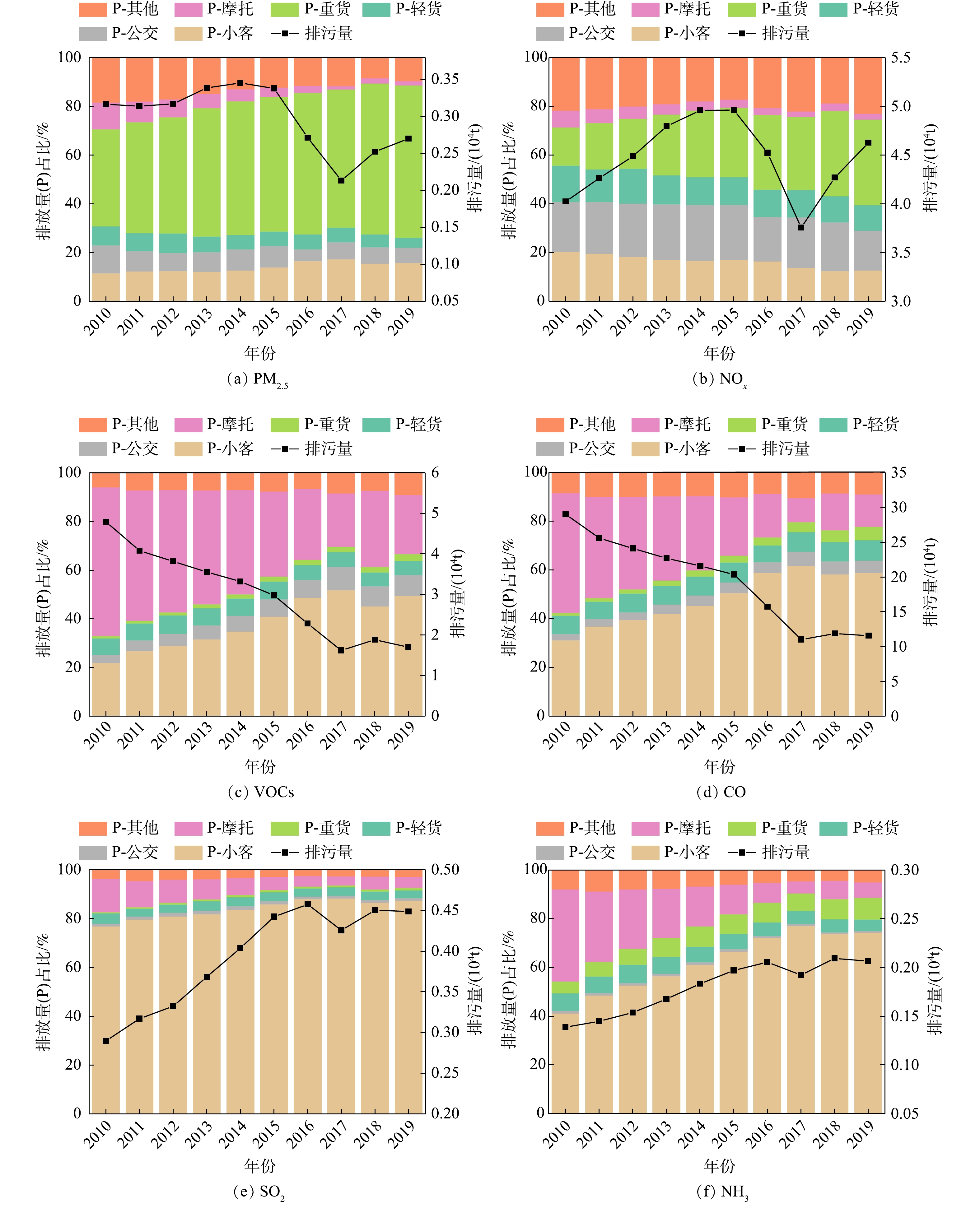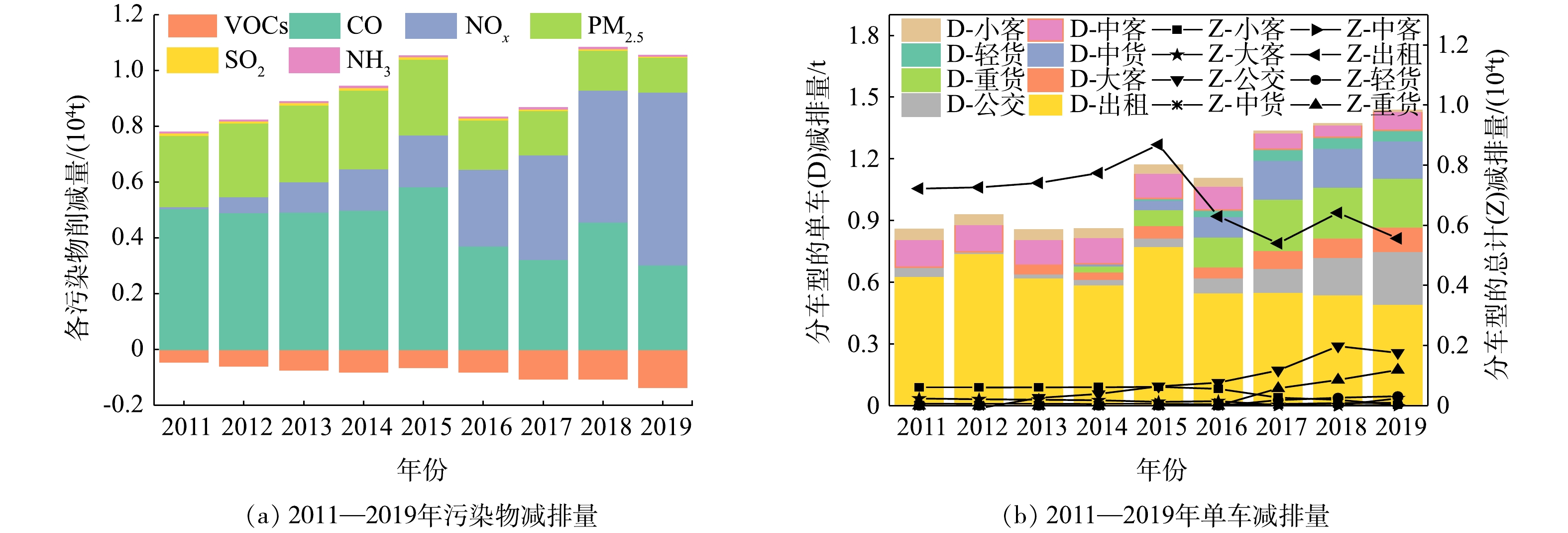-
机动车是重要的大气污染排放源。机动车尾气对大气颗粒物有重要贡献,其中的氮氧化物和挥发性有机物等亦是臭氧的重要前体物[1-2],能给人群健康带来不利影响[3]。近年来,机动车尾气排放因子[4-6]、清单[7-10]、模型[11-13]以及未来发展趋势[14-17]等成为机动车污染防治领域的研究热点。研究者在识别机动车尾气排放特征、污染空间分布、对区域环境影响等方面取得的重要成果,有助于全面认识机动车尾气污染,还可为政府部门的管理决策提供支撑。
通过防控措施减排效果评估,可获得各种措施的污染减排量、经济成本效益等指标,以确定最适用的减排方案,是机动车尾气排放研究的重要领域。卢亚灵等[18]分析了京津冀地区提前淘汰黄标车和黄标车禁行2种措施的减排效果,发现提前淘汰黄标车并予以补贴的减排效益更明显;谢鹏飞等[19]研究了京津冀地区燃油品质升级后的减排效益,认为升级燃油品质标准可有效降低单车排放因子,尤其是对VOCs和PM具有较好的减排效果;樊守彬等[20]对北京城市副中心未来的机动车排污情况进行了预测,表明淘汰高排放车辆只能在短期内实现较好的减排效果,推广清洁能源汽车方可取得持续性的减排效果;唐代茂等[21]评估了兰州市在2016年推行冬季机动车单双号限行政策期间的空气质量状况,结果表明,分时段单双号限行可取得较好的减排效果,而全天限行并不能明显提升减排效果;杨雯等[22]对京津冀机动车设置了13种政策评估情景,发现淘汰高污染排放标准机动车可减少京津冀地区近50%的CO和HC排放。以上研究表明,常见的政策措施在机动车尾气减排上均可取得正向效益,但减排效果却不尽相同,这是由于研究区域的车队结构、措施类别、资源禀赋、社会经济发展等因素的差异会产生相应经济效益、社会效益的改变,随之影响减排的效果。
成都市是国务院确定的国家重要高新技术产业基地、商贸物流中心和综合交通枢纽,是西部地区重要的中心城市[23]。近10年来,成都市机动车快速增长,给当地大气质量带来了极大挑战。为减少汽车尾气污染,成都市政府实施了尾号限行、推广清洁能源汽车等一系列措施,取得了一定成效。本研究以成都市机动车污染防控措施为对象,分类整合了2010—2019年出台的防控措施,分析了2010—2019年机动车尾气中污染物的排放特征,评估了关键防控措施的减排效果,以期为成都市及其他同类型城市的机动车尾气污染防治提供参考。
全文HTML
-
为掌握2010—2019年成都市推行的机动车尾气防控措施,搜集了成都市发布的机动车治理相关文件、标准及统计资料等,并对搜集的资料进行梳理归类,整合成为4类减排措施。
-
通过控制机动车保有量、改变单车排放水平,以及降低机动车使用频率等途径可降低区域内机动车的整体排放量,以此达到减排目的。本研究中机动车尾气排放量的计算方法见式(1)。
式中:Qi为污染物PM2.5、NOx、CO、VOCs、SO2、NH3的排放量,t;FEF为污染物排放因子,g·km−1;LVKT为车辆年均行驶里程,km·辆−1;P为机动车保有量,辆;i为污染物种类;j为车辆类型。其中,排放因子参考《道路机动车大气污染物排放清单编制技术指南》(试行)[24]推荐值,年均行驶里程根据实际调查、并参考文献[25]获得,机动车保有量取自历年统计年鉴[26]、相关文献及部分公开数据[25, 27]。本研究未考虑燃油蒸发排污量。此外,基于成都市路网数据,采用ArcGIS将2019年机动车尾气排放量进行了1 km×1 km分配。
-
本研究以2010—2019年成都市机动车实际排放量为“基准排放”,对应的防控措施如表1所示。4类减排措施单独实施时的排放量为“控制排放”。各控制排放下的机动车保有量与对应的基准排放相同。通过对比基准排放和控制排放的排放量来评估每种防控措施的减排效果。4类减排措施分别为:1)加严排放及燃油标准。假定所有新增车辆全执行2010年的排放标准及燃油品质,其他措施不变;2)推广清洁能源汽车。假定所有新增清洁能源车均为燃油汽车且执行相应标准,其他措施不变;3)淘汰高排污车辆。假定所有高排污车辆按照每年5%的比例自然淘汰,其他措施不变;4)优化城市交通管理。假定所有城市交通优化措施未执行,其他措施不变。
1.1. 关键防控措施梳理
1.2. 机动车污染排放特征分析方法
1.3. 关键防控措施类别
-
通过对表1中相关资料的内容梳理,总结了成都市在2010—2019年间发布的机动车尾气防控措施,包括加严排放标准、升级燃油品质、推广清洁能源汽车、淘汰高排放车辆、优化城市交通管理等。防控措施对应的机动车分类及对应的排放标准如表2所示。
在加严排放标准和升级油品方面,成都市的政策基本与国家同步。在推广清洁能源汽车方面,2017年底,成都市清洁能源汽车达到了4.2×104辆;2018年底前主城区将1 500辆公交车、400辆出租车、6 000辆物流车的新增或更换为清洁能源车辆;2019年新增了6 000辆物流配送、邮政快递用清洁能源汽车;预计到2020年末清洁能源汽车将达到10×104辆。在淘汰高排放车辆方面,成都市从2013年5月1日起开始淘汰机关事业单位黄标车;2015年底前基本淘汰了各区县及2005年前注册的运营黄标车;2017年底淘汰了全部黄标车12×104辆,随后又加强了老旧车的淘汰[28]。在优化城市交通管理方面,2010年10月1日起,高污染机动车每日07:30—19:30禁止在绕城高速内行驶;2012年4月26日起7条主干道执行尾号限行政策;2012年6月1日起禁止发动机排量150 mL以上的两轮摩托车在中心城区道路通行;2013年7月1日起每日07:30—20:00在二三环内实行尾号限行;2018年1月1日起国Ⅲ及以下货运车辆禁止入城,同年1月22日起每日07:30—20:00实行绕城内尾号限行;2019年1月1日起国Ⅳ以上货运车入城数控制在6 100辆以内。除此以外,成都市还通过优化运输结构、大力发展公共交通等方式来优化城市交通管理,但这部分措施不易量化,故未将其纳入关键措施评估。
-
图1为2010—2019年间成都市机动车保有量及排污量变化趋势。由图1可以看出,近10年来,成都市机动车增长趋势稳定,机动车保有量从2010年的259.91×104辆增至2019年的576.80×104辆,年均增长率达到9.26%。2019年,PM2.5、VOCs、CO、NOx、NH3和SO2的排放量分别为11.58×104、1.70×104、0.27×104、4.63×104、0.45×104和0.21×104 t,分别比2010年增加了−64.51%、−14.68%、−60.08%、15.00%、54.96%和48.84%,这说明,成都市推行的一系列防控措施有效的削减了机动车CO、VOCs和PM2.5的排放,但仍需加强对NOx、NH3和SO2的控制。
-
图2展示了不同标准的机动车保有量占比及排污总量占比变化趋势。由图2可知,近10年国0、国Ⅰ、国Ⅱ和国Ⅲ车辆保有量占比逐渐下降,国Ⅳ车辆占比先上升后下降,国Ⅴ和国Ⅵ车辆占比逐渐上升;2019年末国0~国Ⅵ车辆占比分别为0%、0.15%、5.68%、15.29%、41.88%、29.96%和7.03%。就排污量而言,成都市机动车排放的污染物主要来自国Ⅱ、国Ⅲ、国Ⅳ和国Ⅴ车辆;2019年综合排污占比中,这几类车辆的排污量分别占总量的13.12%、28.70%、32.78%和20.53%。值得注意的是,保有量占比仅15.29%的国Ⅲ车辆的综合排污占比达到了总量的28.70%。因此,在国0、国Ⅰ和国Ⅱ车辆逐渐淘汰的情况下,国Ⅲ车辆应作为成都市下一步的重点减排对象。
-
图3反映了不同类型机动车保有量占比及排污总量占比的变化。由图3可知,成都市小型客车保有量最大、占比高,从2010年的52.19%提升至2019年的84.15%,年均增长率达到15.15%;摩托车保有量占比则从2010年的39.78%降低到2019年的9.07%,保有量年均增长率为−7.35%;其他车型保有量占比变化不大。小型客车的快速增加和摩托车的持续减少说明成都市车队结构发生了改变,各类机动车的排污总量构成也随之改变。经分析可知,小型客车排污总量占比在2017年之前逐渐增加,随后出现下降,2019年约为47.02%;而摩托车排污总量占比逐年减小,2017年后逐渐稳定,到2019年约为11.18%;公交车和重型货车的排污总量占比相对较小,但呈现出明显的上升趋势,在2019年分别达到了8.02%和13.31%;其余车辆排污占比较稳定,为9.48%~12.48%。
-
成都市不同类型机动车对污染物的贡献占比如图4所示。由图4(a)可知,2010—2019年,重型货车对PM2.5贡献率最大,从2010年的39.81%增至2019年的62.62%,其次为小型客车,占比为11.67%~17.39%;重型货车对NOx贡献占比亦为最大,从2010年的15.59%增加到2019年的35.08%,其次为公交车、小型客车和轻型货车,分别为16.32%~23.02%、12.84%~20.49%、10.42%~14.59%,呈现缓慢的下降趋势(见图4(b))。由图4(c)~图4(f)可知,小型客车是VOCs、CO、SO2和NH3的主要贡献车型,2019年的排污占比分别为49.63%、58.96%、74.41%和87.49%,分别比2010年增长了24.99%、17.07%、33.23%和9.61%;而摩托车对VOCs、CO、SO2和NH3的贡献则逐年下降,2019年的贡献率分别为24.26%、27.34%、63.83%和44.27%,分别比2010年下降了36.93%、21.73%、31.33%和9.21%;其余车型排污占比基本不变。以上结果说明成都市机动车结构在这10年间发生了明显变化,小型客车明显增加、摩托不断减少,造成排污构成的变化呈现上述趋势。
-
图5是2019年成都市机动车排污空间分布图。由图5可知,每种污染物的排放都呈现出由中心城区向郊区递减的排放趋势:一圈层的武侯区、青羊区、金牛区、成华区、锦江区等区域路网相对密集、交通流量大,单个网格排放量较高,PM2.5、NOx、CO、VOCs、NH3和SO2的排放量在2.16、16.81、58.32、14.34、2.87、1.26 t·(a·km2)−1以上;二圈层大部分区域以及整个三圈层的路网相对较稀疏、交通流量较小,其排放量也相对较低,上述6种污染物在二圈层的排放量分别为0.43~2.15、4.24~16.80、15.58~58.31、3.67~14.33、0.63~2.86、0.27~1.25 t·(a·km2)−1;而6种污染物在三圈层的排放量分别在0.42、4.23、15.47、3.66、0.62、0.26 t·(a·km2)−1以下。这是由于成都国际集装箱物流园区、航空物流园区等大型物流园区主要分布在二圈层区域,所以重型柴油货车在该区域活动频繁、保有量较大,导致其中个别区域排放量较高。周子航等[25]对2016年成都市机动车排放清单做了空间分配,二三圈层的排放强度低于本研究的结果,而在中心城区则略高于本研究的结果。这可能是由于近年来成都市周边区县的机动车保有量快速增长,导致其排放强度增加,而中心城区由于地铁等公共交通、电动汽车的大力推行,其排放强度则降低。
-
2010年成都市车辆排放和燃油品质执行国Ⅲ排放标准。假定该措施下,排放标准和燃油品质与2010年相同,其他条件与基准排放一致,其减排量如图6所示。由图6(a)可知,综合减排量逐年增加,CO、NOx和VOCs的削减效果明显,减排贡献主要来自国Ⅳ和国Ⅴ车辆;2019年减排总量达到10.92×104 t,国Ⅳ、国Ⅴ和国Ⅵ标准车辆所产生的减排量分别达到4.49×104、4.64×104、1.78×104 t。图6(b)为各种车型的单车减排量和减排总量,表明公交车、大型客车等车型的单车减排量较大,2019年分别达到0.41和0.29 t;从车型来看,小型客车减排总量最大,2019年的减排量达到7.14×104 t,其余车型减排总量则相对较小。
-
使用清洁能源汽车是成都市较早实行的减排措施之一,重点在出租车、公交车等领域推广。清洁能源汽车主要指以燃气、电力、油电混合为动力的车型。本措施假设2011—2019年所有清洁能源汽车全部改为燃油汽车,其他条件与基准排放一致,减排量如图7所示。由图7(a)可知,该措施下每年减排量接近;CO、NOx、PM2.5减排效果显著;VOCs却呈现出了增加,2019年VOCs的减排量为−0.13×104 t。这是由于本研究中涉及的汽车排放因子参考《道路机动车大气污染物排放清单编制技术指南》(试行)[24],燃油汽车VOCs的排放因子低于燃气车辆,所以该措施下VOCs排放量低于基准排放。由图7(b)可知,该措施下出租车的单车减排量及减排总量都最大,2019年分别达到0.49和0.56×104 t,其余车型减排量相对较小。
-
淘汰高排放车辆(黄标车和老旧车)是减少机动车尾气排放的重要措施,成都市在2017年底基本完成了高排放车辆的淘汰任务。本措施假设所有高排放车辆仅按照每年5%的比例自然淘汰,其他条件与基准排放一致,其减排量如图8所示。由图8(a)可知,该措施下减排量逐年增加,主要是CO、NOx、VOCs的削减;而2016年后大多数高排放车辆已经淘汰,故2016—2019年间的减排量比较接近;2019年CO、NOx、VOCs、PM2.5、SO2、NH3的减排放量分别为2.62×104、0.98×104、0.34×104、0.13×104、0.01×104、0.007×104 t;从标准减排来看,该措施下国0车辆减排量远高于国Ⅰ和国Ⅱ车辆,2019年的减排量分别为2.71×104、0.56×104、0.82×104 t。由图8(b)可知,公交车、大型客车的单车减排量较大;小型客车、轻型货车和中型货车的减排总量较高;2019年,小型客车、轻型货车、中型货车的减排总量分别为1.32×104、0.96×104和0.95×104 t,其余车型减排总量相对较小。
-
优化城市交通管理是成都市的关键减排措施之一,包括道路限行、区域限行等方式。本措施假设2011—2019年成都市的交通优化管理措施未实施,其他条件与基准排放一致,减排量如图9所示。由图9(a)可知,减排量在2013年达到最大,随后逐渐降低,2017年之后又逐渐上升,这与当地政府采取的限行政策关系密切。2019年,CO、NOx、VOCs、NH3、PM2.5、SO2的减排放量分别为2.55×104、0.81×104、0.38×104、0.11×104、0.04×104、0.05×104 t。由图8(b)可知,单车减排量也呈现出高低交替变化的趋势。大型客车、公交车、中型客车、出租车的单车减排量较大,2019年分别达到0.11、0.11、0.07和0.06 t。小型客车减排总量较大,摩托车的减排总量波动较大,2019年的减排量分别为2.21×104和0.42×104 t。
-
以上结果表明,成都市所制定的机动车尾气减排措施均取得了较好的效果,但不同措施的减排量各不相同(见图10):加严排放及燃油标准的减排量最显著,其次为优化城市交通管理和淘汰高排放车辆,推广清洁能源汽车的减排量最小。以上结果与金嘉欣等[29]对辽宁机动车减排研究相似,加严排放标准对减排有明显影响;而王同猛等[30]对西安市机动车控制策略研究表明,使用天然气替代燃料的减排量最小,淘汰黄标车和老旧车的的效果最显著。唐伟等[31]在杭州市的发现与本研究结果存在差异,淘汰高排放老旧车的减排效果最好,这可能与该城市的机动车保有量、车队结构等有关,同时也表明只有充分考虑车队结构、排放特征等前提制定的减排措施方可达到较好的效果。
另外,加严排放标准对小型客车、轻型货车、重型货车、公交车的减排作用明显,能有效降低NOx、VOCs、CO和NH3等的排放;推广清洁能源汽车对出租车、公交车的减排效果显著,可明显减少PM2.5的排放,但未能很好控制VOCs的排放;淘汰高排放车辆对小型客车、轻型货车、中型货车等的减排作用较明显,使得NOx、CO等的排放大幅降低;优化城市交通管理则对小型客车和摩托车的减排作用显著,有效降低了NOx、VOCs和CO的排放。有研究表明,机动车是我国大气中VOCs的最大贡献源[32-34],平均贡献率达到36.8%,芳香烃和烯烃等VOCs对二次污染的贡献较大。本研究发现,推广清洁能源汽车会导致VOCs排放的增加,这可能是由于燃气车辆的增加带来的VOCs排放,因此,推广清洁能源汽车的减排效益还有待进一步论证。
2.1. 关键防控措施及执行情况
2.2. 2010-2019年成都市机动车尾气污染物排放特征分析
2.2.1. 总体趋势
2.2.2. 不同排放标准的机动车保有量与污染物排放量的关系
2.2.3. 不同类型机动车保有量与污染物排放量的关系
2.2.4. 不同类型机动车对污染物排放的贡献
2.2.5. 成都市机动车污染物的空间分布特征
2.3. 防控措施减排效果评估
2.3.1. 加严排放及燃油标准的效果评估
2.3.2. 推广清洁能源汽车的效果评估
2.3.3. 淘汰高排放车辆后的效果评估
2.3.4. 实施限行等优化城市交通管理的效果评估
2.4. 各类防控措施的污染物减排效果对比
-
1)近10年来,成都市车队结构发生了明显变化,小型客车明显增加而摩托不断减少,机动车保有量整体逐渐上升,但尾气排放总量整体呈现下降趋势,下一步应将国Ⅲ车辆应作为重点减排对象。
2)受路网、机动车保有量、交通流等因素影响,成都市机动车尾气排放呈现出由中心城区向郊区递减的趋势,中心城区的PM2.5、NOx、CO、VOCs、NH3和SO2排放量最大,而物流园区的排放对二圈层的排污影响较大。
3)成都市机动车尾气关键防控措施效果最好的是加严排放和燃油标准,其次为优化城市交通管理和淘汰高排放车辆,推广清洁能源汽车的减排量最小,且推广燃气车辆可能会增加VOCs排放,其减排效益有待进一步论证。





 DownLoad:
DownLoad:
